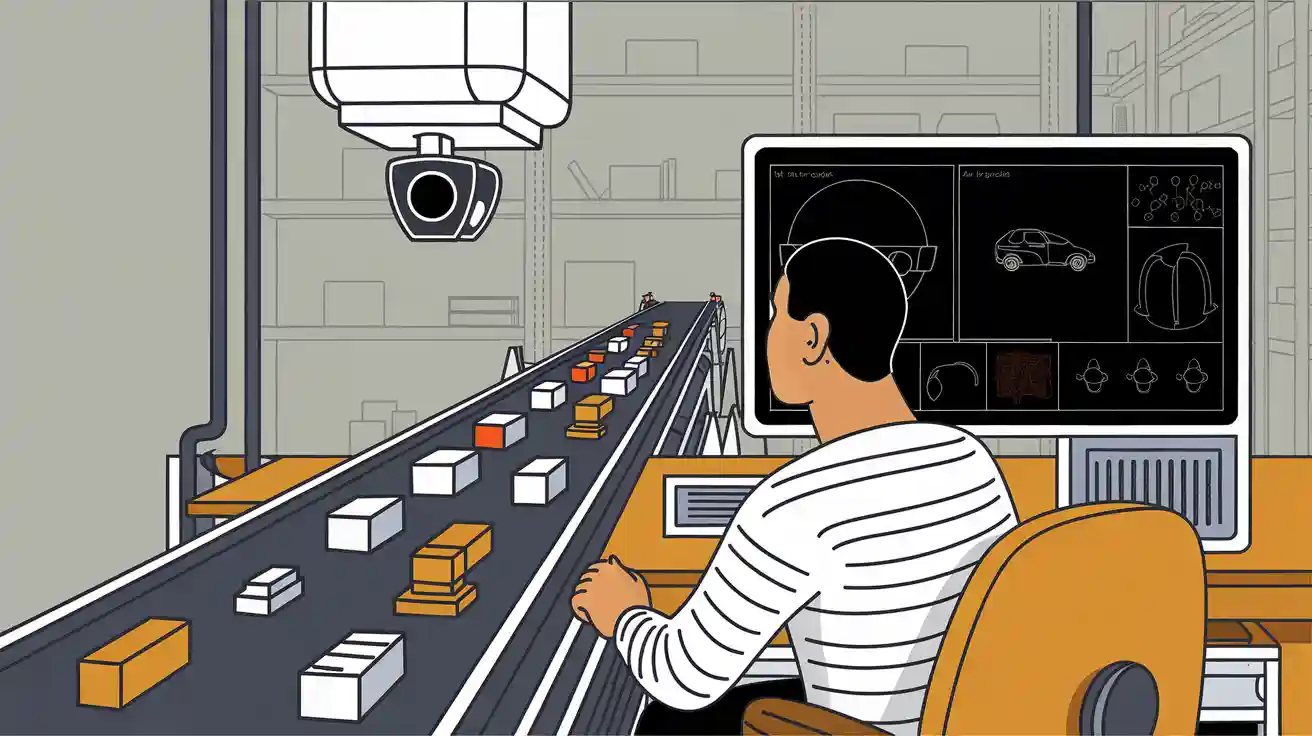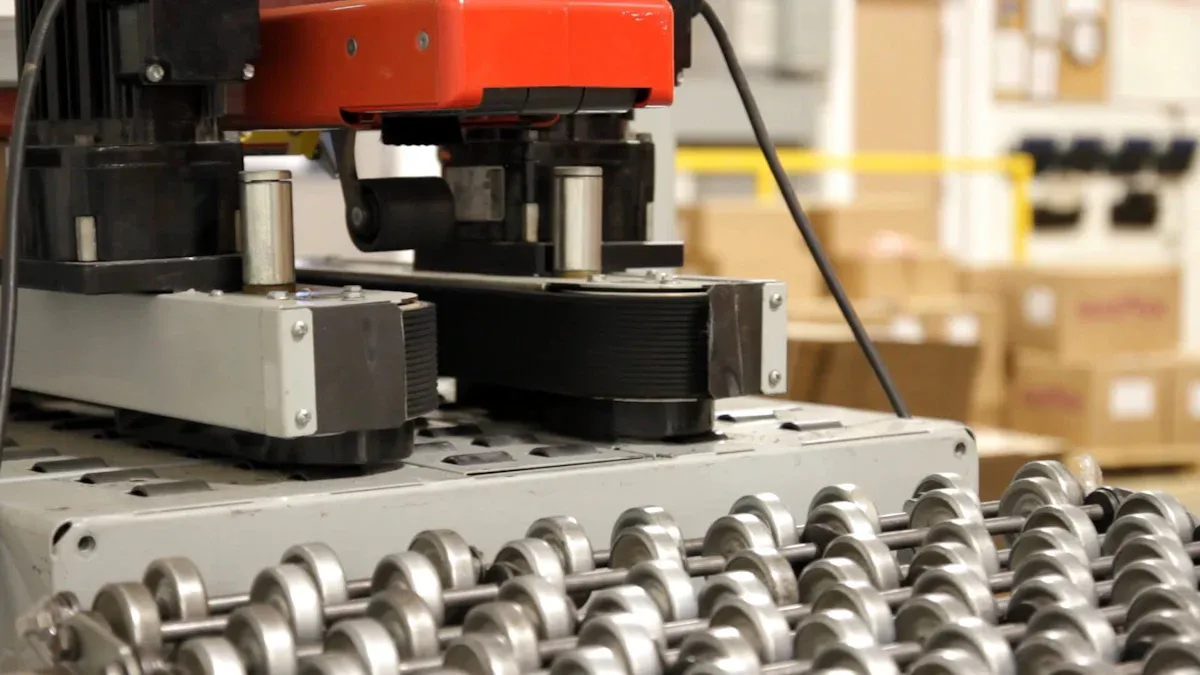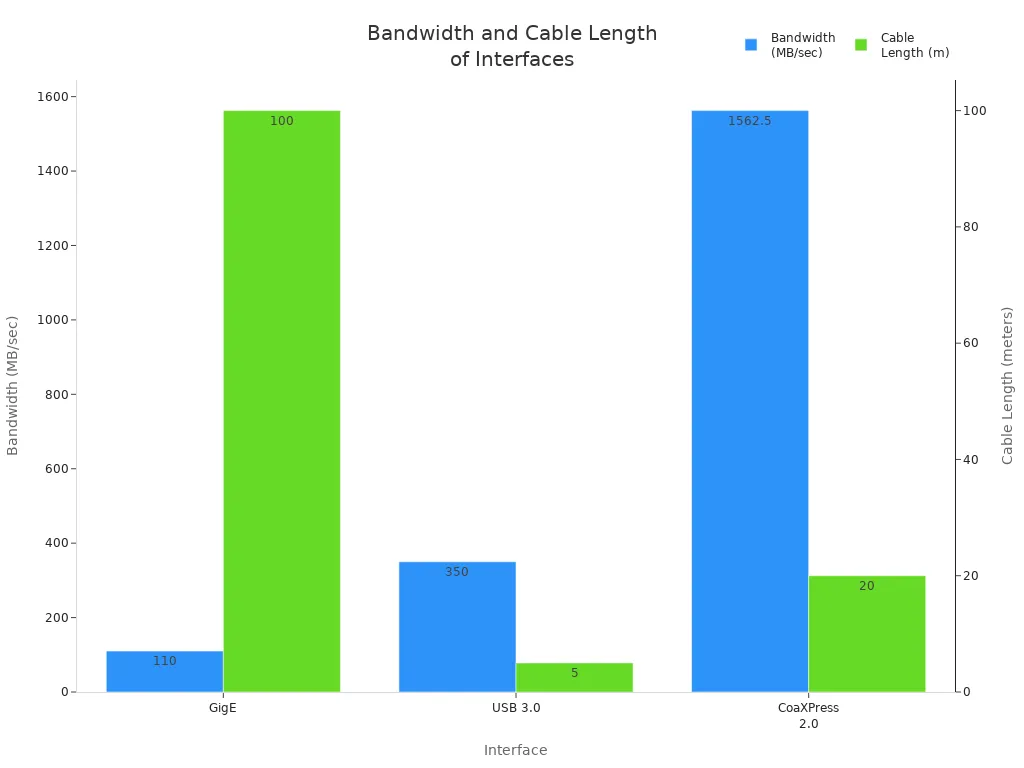
A line rate machine vision system uses specialized cameras to inspect objects moving quickly along a production line. This technology captures images one line at a time, building a full picture as items pass by. Many industries rely on these systems to improve quality and speed.
| Industry | Adoption Level |
|---|---|
| Semiconductor | Highest |
| Automotive | Significant |
| Manufacturing | Major |
| Healthcare | Growing |
People see line rate machine vision system technology in action every day, from car factories to electronics assembly. This system helps companies deliver safer, more reliable products.
Key Takeaways
- Line rate machine vision systems capture images one line at a time to inspect fast-moving products with high accuracy and speed.
- These systems help industries like manufacturing, food, and electronics detect defects early, improve quality, and reduce waste.
- Line scan cameras differ from area scan cameras by capturing continuous lines, making them ideal for fast-moving objects but requiring precise synchronization.
- Proper setup, including lighting, calibration, and synchronization, is essential to avoid errors and ensure clear, reliable images.
- Investing in these systems boosts productivity, lowers inspection costs, and supports automation for future growth.
What Is a Line Rate Machine Vision System?
A line rate machine vision system inspects moving objects by capturing images one line at a time. The term "line rate" refers to the number of image lines a camera can capture each second. This measurement is crucial because it determines how quickly and accurately the system can inspect products on a fast-moving production line. High line rates allow the system to keep up with rapid manufacturing speeds, ensuring that no defects go unnoticed.
Key Features
A line scan camera forms the heart of a line rate machine vision system. Instead of taking a full picture at once, the camera captures a single row of pixels. As the object moves past the camera, these rows combine to create a complete image. This process is called line scan imaging. Modern line scan cameras can achieve impressive speeds. For example, many current models capture between 10,000 and 20,000 lines per second. Some advanced cameras, such as the JAI SW-4000T-CXPA, reach up to 97,000 lines per second at 4K resolution. These high line rates are essential for industries that need to inspect thousands of items every minute.
Tip: High line rates help manufacturers avoid production bottlenecks and maintain product quality, even at top speeds.
Key features of a line rate machine vision system include:
- Ability to inspect continuous or fast-moving materials, such as textiles, paper, or metal sheets.
- High resolution over large areas, making it possible to detect tiny defects.
- Real-time processing with powerful CPUs or GPUs and optimized lighting.
- Consistent image quality, even when inspecting objects moving at 10 meters per second or more.
How It Differs
Line scan cameras differ from area scan cameras in several important ways. The table below highlights the main differences:
| Aspect | Line Scan Cameras | Area Scan Cameras |
|---|---|---|
| Image Acquisition | Capture one line of pixels at a time; require movement of object or camera to build a full image. | Capture entire 2D image in a single frame; no movement synchronization needed. |
| Synchronization | Needs precise synchronization with object movement to avoid distortion. | No synchronization needed; simpler setup for static or slow-moving objects. |
| Sensor Structure | Long, narrow sensor with pixels arranged in a single row. | Rectangular sensor with pixels arranged in a grid. |
| Use Cases | High-speed processing, continuous moving objects, detailed inspections. | Static or slower-moving objects, discrete components inspection. |
| Advantages | Higher resolution over large areas; seamless images for fast-moving objects. | Simpler integration; handles various shapes and speeds; widely compatible with existing systems. |
| Limitations | Complex integration; higher cost due to motion control and lighting; unsuitable for stationary scenes. | Limited resolution for large surfaces; possible motion blur with fast-moving objects. |
Line scan cameras excel in applications where materials move continuously, such as fabric or paper inspection. They provide high-quality images without motion blur, thanks to their ability to synchronize with the object’s speed. In contrast, area scan cameras work best for static or slow-moving objects, like bottles or electronic parts, where a single snapshot is enough.
The line rate machine vision system stands out for its ability to deliver fast, accurate inspections. High line rates mean the system can check thousands of parts per minute, reducing errors and catching defects early. This advantage leads to better product quality and lower costs for manufacturers.
How It Works
Core Principles
A line scan camera operates by capturing a single row of pixels at a time. This row forms the foundation of the image. As the object moves past the camera, the system collects many rows in rapid succession. The camera then assembles these rows to create a complete image of the object. This process is known as line scan imaging. The line rate, which measures how many lines the camera captures per second, determines how quickly the system can inspect moving items. High line rates allow the system to keep up with fast conveyor belts and ensure no detail is missed.
The camera’s sensor, often a one-dimensional (1D) array, plays a key role. The sensor detects light and converts it into electrical signals. The system then processes these signals to build a high-resolution image. The speed of the conveyor and the line rate must match closely. If the object moves too quickly or too slowly compared to the camera’s capture rate, the image may appear stretched or compressed.
Modern systems use advanced features like burst mode to handle sudden increases in production speed. Burst mode allows the camera to capture images at even higher rates for short periods. This feature helps manufacturers avoid missing defects during peak production times.
Synchronization
Synchronization ensures the camera captures images at the exact moment the object passes by. Two main methods help achieve this: time-based synchronization and distance-based synchronization. Time-based synchronization works well when the conveyor speed remains constant. The system uses a timer to trigger the camera at regular intervals. Distance-based synchronization uses encoders attached to the conveyor. These encoders send pulses that match the distance the object travels. The camera uses these pulses to trigger image capture, which prevents distortion even if the speed changes.
Accurate synchronization is critical for high-speed inspection. When the camera and sensors work together, they capture clear images without motion blur. Photoelectric sensors detect the object’s position, and the system uses fast triggers to control exposure time. This coordination allows the system to achieve precise positioning, often within 0.1 millimeters. The result is a sharp, reliable image that supports quality control.
Note: Without proper synchronization, images may suffer from motion blur, light leakage, or timing errors. These issues can lead to missed defects and lower product quality.
Controllers such as PCs, PLCs, or smart cameras manage the timing and sequencing. PCs often handle complex synchronization tasks, while PLCs work well for applications needing millisecond-level timing. Smart cameras can manage simpler setups. In advanced systems, synchronization also coordinates lighting and multiple cameras, ensuring every part of the object receives the right inspection.
Components
A line rate machine vision system relies on several key hardware components. Each part contributes to the system’s ability to capture and process images at high speed and resolution.
| Hardware Component | Description |
|---|---|
| Image Sensors | Convert light into electrical signals; main types are CCD and CMOS sensors, essential for capturing images quickly and accurately. |
| Machine Vision Lenses | Capture light and focus images; types include manual, autofocus (for dynamic focusing), and liquid lenses (fast, durable focus adjustment). |
| Machine Vision Lighting | Primarily LED-based lighting providing precise, consistent illumination critical for image quality and system reliability. |
| Cameras | Capture images with high resolution (0.35 to 64 MP); include line scan and area cameras suited for different inspection needs. |
Technologies like TurboDrive™ boost system performance. TurboDrive™ enables some cameras to reach frame rates up to 800 frames per second while maintaining full image quality. This technology supports applications that demand rapid image acquisition. The system’s performance also depends on pixel size and sensor resolution. Smaller pixels and higher resolution allow the camera to detect tiny defects, even at high speed. The combination of advanced technology and precise hardware ensures the system delivers reliable, high-quality inspection results.
Benefits of Machine Vision Systems
Speed and Efficiency
Line rate machine vision systems deliver unmatched speed in industrial inspection. These systems can inspect thousands of components per hour, far surpassing manual methods. Real-time defect detection and automated quality control allow factories to reach maximum line speed without sacrificing accuracy. Vision-guided robots process up to 10,000 parts per hour, which boosts throughput and reduces bottlenecks. The table below highlights measurable improvements:
| Improvement Metric | Measurable Improvement |
|---|---|
| Reduction in inspection errors | Over 90% reduction compared to manual methods |
| Reduction in defect rates | Up to 80% reduction in defects |
| Reduction in cycle time | Up to 20% reduction in inspection cycle time |
| Throughput | Thousands of components per hour |
Automated systems also reduce downtime by identifying equipment wear early, supporting predictive maintenance. This efficiency leads to faster production cycles and higher overall performance.
Accuracy and Quality
Machine vision systems provide high resolution and consistent inspections. They outperform manual inspection by eliminating human error and fatigue. These systems achieve accuracy rates above 99% in defect detection and object identification. In electronics manufacturing, defect detection rates increased to 97.2% after improving data quality. Real-time monitoring and validation frameworks catch errors quickly, ensuring continuous quality control.
- Machine vision systems inspect every item uniformly, reducing variability.
- AI integration enables adaptive learning, improving defect detection over time.
- Industries report a 30% increase in defect detection accuracy and a 50% reduction in inspection time.
High resolution imaging allows detection of even the smallest flaws, which helps maintain product consistency and safety.
Cost Savings
Automating inspection with machine vision systems leads to significant cost savings. Companies report up to a 50% reduction in quality assurance labor costs. Lower defect rates mean less scrap and fewer customer returns. For example, some factories reduced false rejects from 12,000 to just 246 units weekly, saving millions each year.
| Efficiency Aspect | Impact/Metric |
|---|---|
| Reduction in labor costs | Approximately 50% |
| Improvement in robotic efficiency | Over 40% |
| Productivity improvement | 40% boost compared to manual methods |
Continuous operation at high speed and high resolution ensures fewer errors and less waste. These savings make machine vision systems a smart investment for any industry focused on quality and efficiency.
Detection and Defect Detection Applications

Manufacturing
Manufacturers rely on line rate machine vision systems to inspect products at high speed and with great accuracy. These systems detect surface flaws such as scratches, cracks, and discoloration. They also perform dimensional inspection, measuring parts with micron-level precision. Factories use these systems for packaging integrity checks, including 360-degree bottle inspection for cap closure and label positioning. Fill level inspection prevents overfilling or underfilling in containers. Pharmaceutical companies use these systems to inspect tablets for color, size, and wholeness, automatically rejecting faulty products.
- Surface flaw detection for scratches, cracks, and discoloration
- Dimensional inspection and gauging with non-contact measurement
- Packaging integrity verification and fill level inspection
- Pharmaceutical tablet inspection for color and dimension
- Robotic guidance for precision assembly
Line rate machine vision systems excel in continuous material inspection. They capture images one line at a time, making them ideal for fast-moving conveyor belts in industrial machine vision applications.
Food and Beverage
In the food and beverage industry, line rate machine vision systems automate quality assurance. These systems use advanced image processing and machine learning to inspect products rapidly without slowing production. They detect contaminants, packaging defects, and labeling errors. Real-time monitoring allows immediate corrective actions, reducing waste and downtime. The systems verify packaging integrity and support regulatory compliance by capturing detailed data such as batch numbers and packaging codes.
- Detection of foreign objects and contamination
- Packaging seal and label verification
- Fill level and container integrity checks
- Traceability through lot and date code verification
These systems help companies maintain high safety standards and consistent product quality, even in fast-paced environments.
Electronics
Electronics manufacturers face challenges such as detecting micro-defects and handling complex anti-counterfeiting features. Line rate machine vision systems provide high-speed, accurate inspection to catch subtle inconsistencies that manual checks might miss. They read barcodes, verify serialization, and inspect circuit boards for faulty pins. Real-time feedback enables immediate error correction, reducing waste and improving efficiency. These systems adapt to different lighting and material conditions, ensuring reliable results.
- Micro-defect detection in circuit boards
- Barcode and serialization verification
- Real-time feedback for process improvement
- Integration with existing production workflows
Automated defect detection systems in electronics achieve high reliability, with some reaching recall rates of 100% and F1 scores above 92%.
Choosing a System
Key Factors
Selecting the right line rate machine vision system requires careful attention to several important factors.
- Software should be simple and well-tested to ensure reliable inspection results.
- Scalability matters for future production growth and performance needs.
- The technology must match the application, such as using line-scan cameras for fast-moving items.
- Environmental conditions, like temperature and dust, affect hardware choices.
- Sensor type and resolution must fit the detail and speed required.
- Interface standards, including USB 3.0, GigE, CoaXPress, and camera link, impact compatibility and data flow.
- Camera housing should withstand industrial environments.
- Dynamic range and sensitivity help manage changing lighting.
- Triggering and synchronization features are vital for precise timing.
- Supplier reputation and support influence long-term success.
| Factor | Key Considerations | Application Impact |
|---|---|---|
| Sensor Type | Global vs. rolling shutter; monochrome vs. color | Motion capture accuracy, sensitivity, color info |
| Resolution | Match to smallest feature and AI needs | Detection accuracy, processing load, throughput |
| Interface Standards | USB 3.0, GigE, CoaXPress, camera link | System architecture, scalability, compatibility |
| Camera Housing | IP ratings, temperature, vibration resistance | Durability, reliability |
| Dynamic Range | Bit depth, sensitivity | Image quality under varying lighting |
| Triggering/Synchronization | Hardware/software triggers, GPIO, PLC integration | Timing accuracy, multi-camera coordination |
Integration
Proper integration ensures smooth operation and high-quality images.
- Test all components for compatibility before setup.
- Use positioning equipment that matches the camera, lens, and lighting to avoid distortion.
- Select lighting, such as LED, for clear and even images.
- Calibrate equipment regularly to maintain accuracy.
- Use software tools for alignment and real-time monitoring.
- Document maintenance and service schedules for reliability.
Tip: Define frame rate and shutter speed early to optimize image capture and reduce distortion.

Common Pitfalls
Many users face challenges during setup and operation:
- High-quality sensors and hardware can be expensive and need expert installation.
- Achieving accuracy is difficult with changing lighting or reflective products.
- Calibration and installation often require special training.
- Integration can be complex if platforms are incompatible.
- High initial costs and ongoing maintenance may strain budgets, especially for small businesses.
- Without regular training and maintenance, the system may fail or lose accuracy.
Regular calibration and staff training help prevent costly errors and downtime.
Line rate machine vision systems deliver fast, accurate inspections for many industries. These systems improve product quality, boost productivity, and support automation. Key benefits include:
- Early defect detection and reduced waste
- Traceability through code reading
- Increased safety by reducing manual checks
- Adaptability to different lighting and materials
| Future Trend | Description |
|---|---|
| AI Integration | Real-time decisions and better defect detection |
| Smart Factory Demand | More automation in manufacturing and logistics |
| Market Growth | Projected $9.3 billion revenue by 2028 |
Companies seeking higher efficiency and quality should explore these systems for future growth.
FAQ
What is the main advantage of a line rate machine vision system?
A line rate machine vision system inspects fast-moving products with high accuracy. It captures images one line at a time, which helps detect small defects and maintain product quality.
How does a line scan camera differ from an area scan camera?
| Feature | Line Scan Camera | Area Scan Camera |
|---|---|---|
| Image Capture | One line at a time | Full image at once |
| Best Use | Moving objects | Stationary objects |
Can these systems work in low-light environments?
Many line rate machine vision systems use powerful LED lighting. This lighting ensures clear images, even in low-light conditions. Proper lighting setup remains essential for best results.
What industries benefit most from line rate machine vision systems?
- Semiconductor manufacturing
- Automotive assembly
- Food and beverage processing
- Electronics production
These industries use the technology to improve speed, accuracy, and product safety.
See Also
Understanding How Machine Vision Detects Product Flaws
A Comprehensive Guide To Cameras Used In Machine Vision
An Overview Of Electronics In Machine Vision Technology








